Analysis of Litigation, Censures, and Fines in Accounting Practices
VerifiedAdded on 2020/06/06
|7
|1449
|50
Report
AI Summary
This report examines a case of Ernst & Young, a leading audit firm, being fined $2 million due to audit failures for Medicis. The report identifies primary accounting issues, corporate ethics related to internal controls, and ethical standards of leadership that led to the litigation. It presents specific conduct violations, particularly concerning revenue recognition and the acceptance of faulty assumptions. The analysis highlights the failure to comply with GAAP and the lack of appropriate action despite identified inconsistencies. Recommendations are provided for regulators and professional societies to prevent future violations, emphasizing the need for detailed evaluations, amendments in the existing framework, and a focus on ethical compliance within auditing firms. The report underscores the vital role of professional societies in avoiding undesirable behavior and ensuring fair financial reporting.
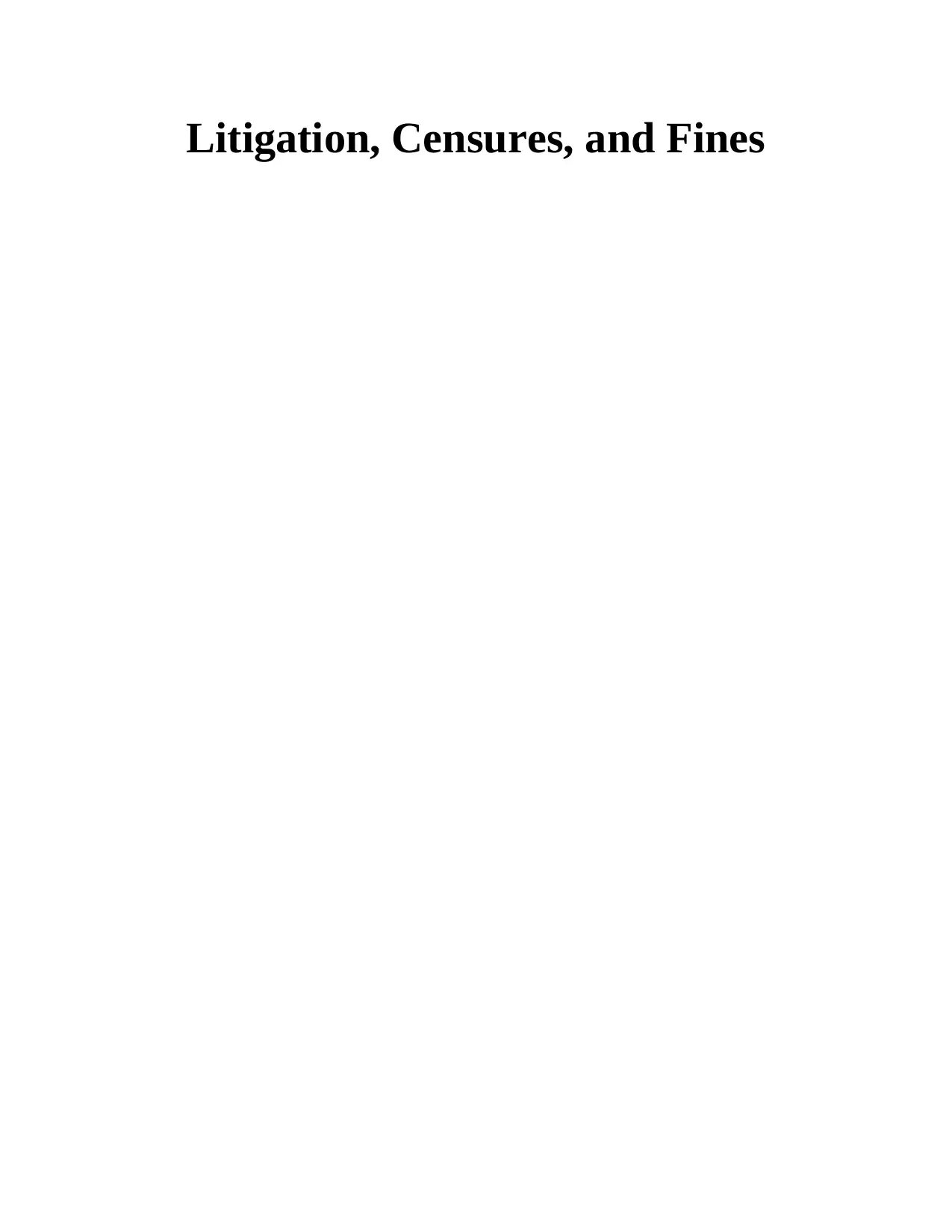
Litigation, Censures, and Fines
Paraphrase This Document
Need a fresh take? Get an instant paraphrase of this document with our AI Paraphraser
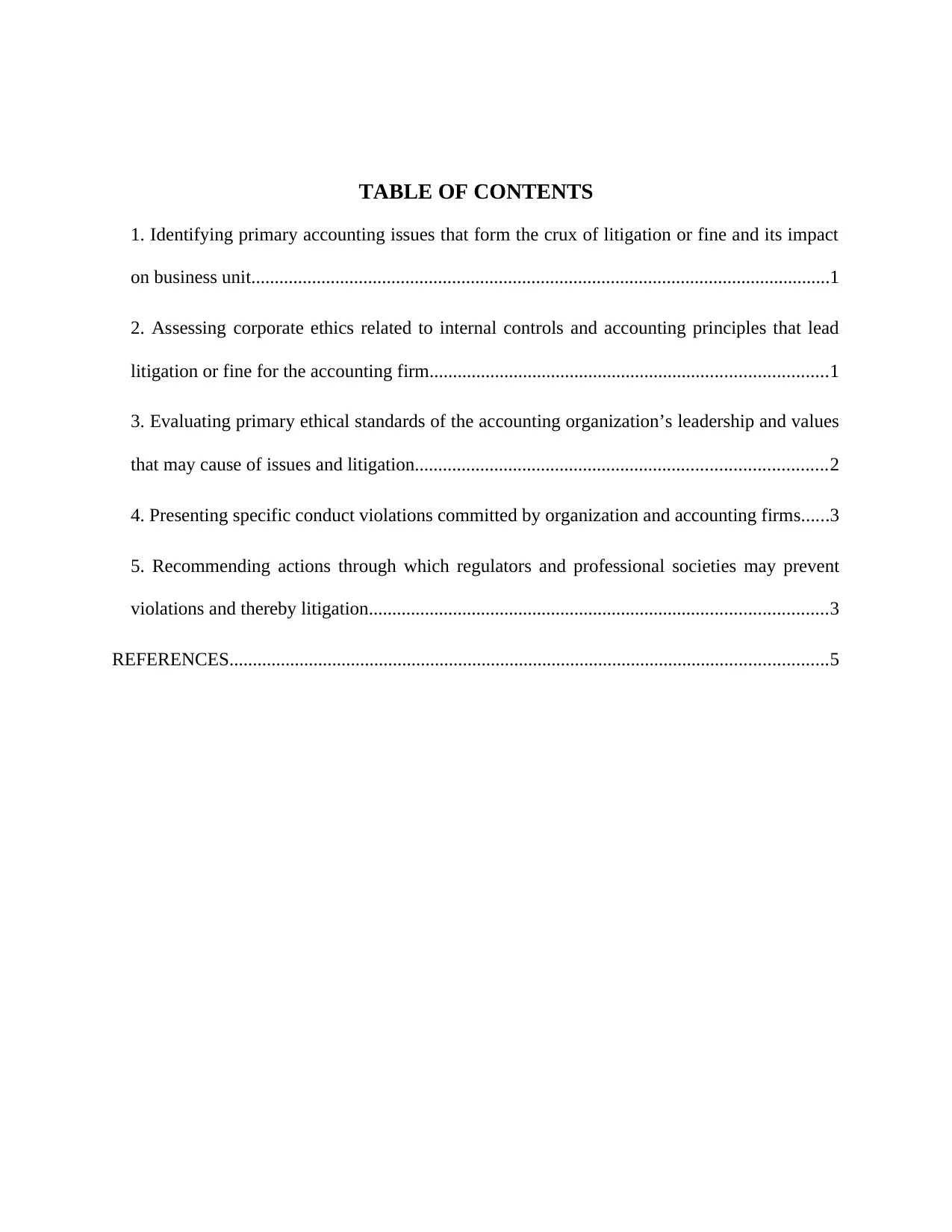
TABLE OF CONTENTS
1. Identifying primary accounting issues that form the crux of litigation or fine and its impact
on business unit............................................................................................................................1
2. Assessing corporate ethics related to internal controls and accounting principles that lead
litigation or fine for the accounting firm.....................................................................................1
3. Evaluating primary ethical standards of the accounting organization’s leadership and values
that may cause of issues and litigation........................................................................................2
4. Presenting specific conduct violations committed by organization and accounting firms......3
5. Recommending actions through which regulators and professional societies may prevent
violations and thereby litigation..................................................................................................3
REFERENCES................................................................................................................................5
1. Identifying primary accounting issues that form the crux of litigation or fine and its impact
on business unit............................................................................................................................1
2. Assessing corporate ethics related to internal controls and accounting principles that lead
litigation or fine for the accounting firm.....................................................................................1
3. Evaluating primary ethical standards of the accounting organization’s leadership and values
that may cause of issues and litigation........................................................................................2
4. Presenting specific conduct violations committed by organization and accounting firms......3
5. Recommending actions through which regulators and professional societies may prevent
violations and thereby litigation..................................................................................................3
REFERENCES................................................................................................................................5
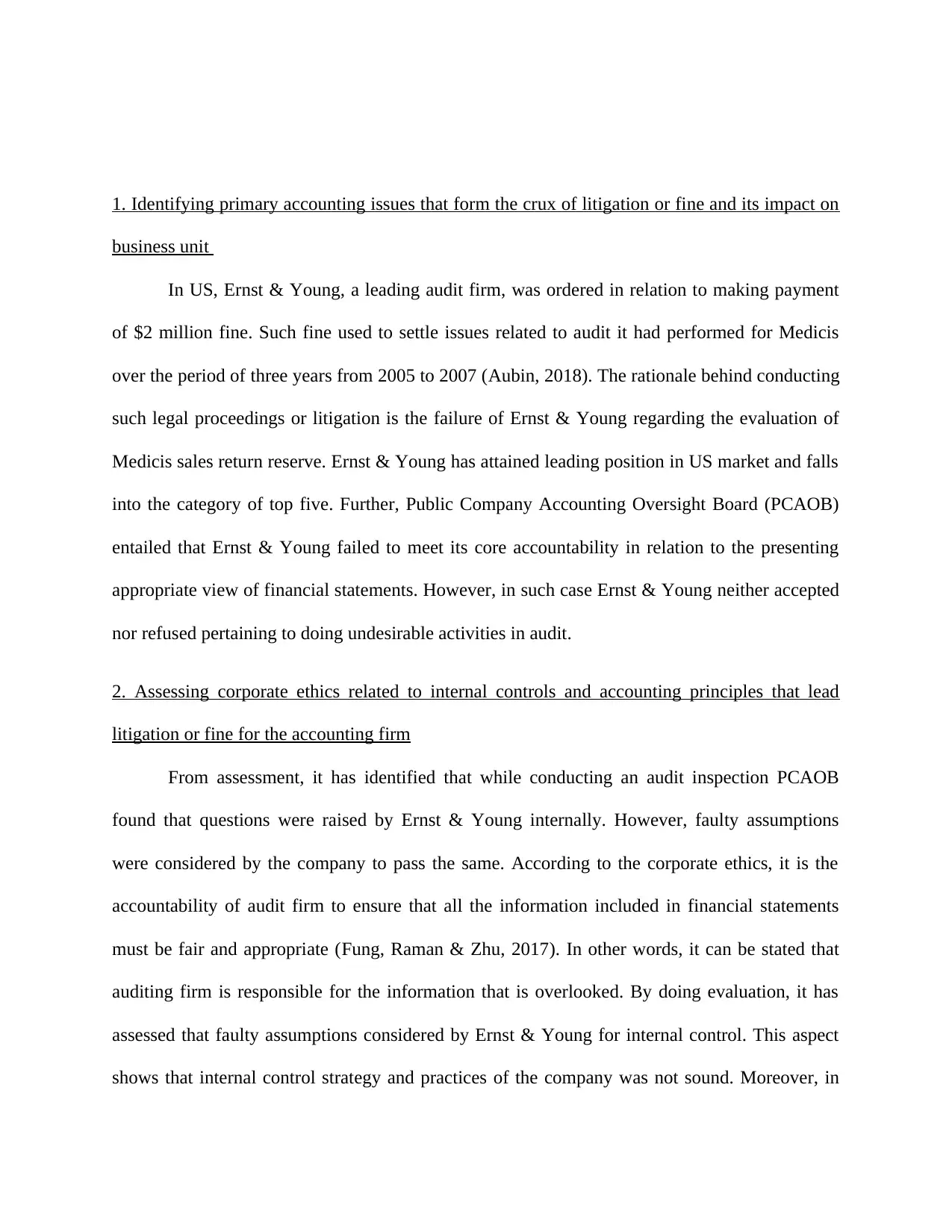
1. Identifying primary accounting issues that form the crux of litigation or fine and its impact on
business unit
In US, Ernst & Young, a leading audit firm, was ordered in relation to making payment
of $2 million fine. Such fine used to settle issues related to audit it had performed for Medicis
over the period of three years from 2005 to 2007 (Aubin, 2018). The rationale behind conducting
such legal proceedings or litigation is the failure of Ernst & Young regarding the evaluation of
Medicis sales return reserve. Ernst & Young has attained leading position in US market and falls
into the category of top five. Further, Public Company Accounting Oversight Board (PCAOB)
entailed that Ernst & Young failed to meet its core accountability in relation to the presenting
appropriate view of financial statements. However, in such case Ernst & Young neither accepted
nor refused pertaining to doing undesirable activities in audit.
2. Assessing corporate ethics related to internal controls and accounting principles that lead
litigation or fine for the accounting firm
From assessment, it has identified that while conducting an audit inspection PCAOB
found that questions were raised by Ernst & Young internally. However, faulty assumptions
were considered by the company to pass the same. According to the corporate ethics, it is the
accountability of audit firm to ensure that all the information included in financial statements
must be fair and appropriate (Fung, Raman & Zhu, 2017). In other words, it can be stated that
auditing firm is responsible for the information that is overlooked. By doing evaluation, it has
assessed that faulty assumptions considered by Ernst & Young for internal control. This aspect
shows that internal control strategy and practices of the company was not sound. Moreover, in
business unit
In US, Ernst & Young, a leading audit firm, was ordered in relation to making payment
of $2 million fine. Such fine used to settle issues related to audit it had performed for Medicis
over the period of three years from 2005 to 2007 (Aubin, 2018). The rationale behind conducting
such legal proceedings or litigation is the failure of Ernst & Young regarding the evaluation of
Medicis sales return reserve. Ernst & Young has attained leading position in US market and falls
into the category of top five. Further, Public Company Accounting Oversight Board (PCAOB)
entailed that Ernst & Young failed to meet its core accountability in relation to the presenting
appropriate view of financial statements. However, in such case Ernst & Young neither accepted
nor refused pertaining to doing undesirable activities in audit.
2. Assessing corporate ethics related to internal controls and accounting principles that lead
litigation or fine for the accounting firm
From assessment, it has identified that while conducting an audit inspection PCAOB
found that questions were raised by Ernst & Young internally. However, faulty assumptions
were considered by the company to pass the same. According to the corporate ethics, it is the
accountability of audit firm to ensure that all the information included in financial statements
must be fair and appropriate (Fung, Raman & Zhu, 2017). In other words, it can be stated that
auditing firm is responsible for the information that is overlooked. By doing evaluation, it has
assessed that faulty assumptions considered by Ernst & Young for internal control. This aspect
shows that internal control strategy and practices of the company was not sound. Moreover, in
⊘ This is a preview!⊘
Do you want full access?
Subscribe today to unlock all pages.

Trusted by 1+ million students worldwide
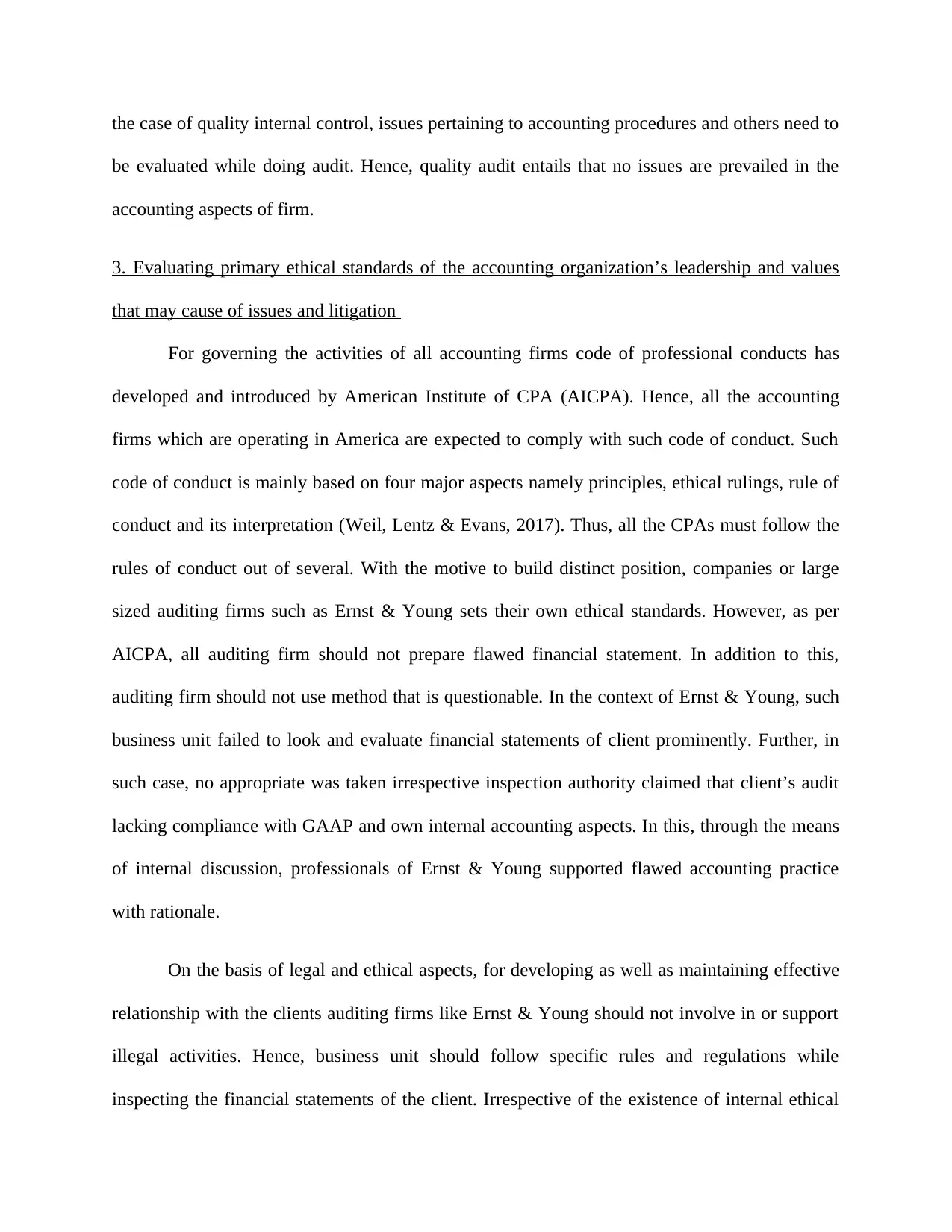
the case of quality internal control, issues pertaining to accounting procedures and others need to
be evaluated while doing audit. Hence, quality audit entails that no issues are prevailed in the
accounting aspects of firm.
3. Evaluating primary ethical standards of the accounting organization’s leadership and values
that may cause of issues and litigation
For governing the activities of all accounting firms code of professional conducts has
developed and introduced by American Institute of CPA (AICPA). Hence, all the accounting
firms which are operating in America are expected to comply with such code of conduct. Such
code of conduct is mainly based on four major aspects namely principles, ethical rulings, rule of
conduct and its interpretation (Weil, Lentz & Evans, 2017). Thus, all the CPAs must follow the
rules of conduct out of several. With the motive to build distinct position, companies or large
sized auditing firms such as Ernst & Young sets their own ethical standards. However, as per
AICPA, all auditing firm should not prepare flawed financial statement. In addition to this,
auditing firm should not use method that is questionable. In the context of Ernst & Young, such
business unit failed to look and evaluate financial statements of client prominently. Further, in
such case, no appropriate was taken irrespective inspection authority claimed that client’s audit
lacking compliance with GAAP and own internal accounting aspects. In this, through the means
of internal discussion, professionals of Ernst & Young supported flawed accounting practice
with rationale.
On the basis of legal and ethical aspects, for developing as well as maintaining effective
relationship with the clients auditing firms like Ernst & Young should not involve in or support
illegal activities. Hence, business unit should follow specific rules and regulations while
inspecting the financial statements of the client. Irrespective of the existence of internal ethical
be evaluated while doing audit. Hence, quality audit entails that no issues are prevailed in the
accounting aspects of firm.
3. Evaluating primary ethical standards of the accounting organization’s leadership and values
that may cause of issues and litigation
For governing the activities of all accounting firms code of professional conducts has
developed and introduced by American Institute of CPA (AICPA). Hence, all the accounting
firms which are operating in America are expected to comply with such code of conduct. Such
code of conduct is mainly based on four major aspects namely principles, ethical rulings, rule of
conduct and its interpretation (Weil, Lentz & Evans, 2017). Thus, all the CPAs must follow the
rules of conduct out of several. With the motive to build distinct position, companies or large
sized auditing firms such as Ernst & Young sets their own ethical standards. However, as per
AICPA, all auditing firm should not prepare flawed financial statement. In addition to this,
auditing firm should not use method that is questionable. In the context of Ernst & Young, such
business unit failed to look and evaluate financial statements of client prominently. Further, in
such case, no appropriate was taken irrespective inspection authority claimed that client’s audit
lacking compliance with GAAP and own internal accounting aspects. In this, through the means
of internal discussion, professionals of Ernst & Young supported flawed accounting practice
with rationale.
On the basis of legal and ethical aspects, for developing as well as maintaining effective
relationship with the clients auditing firms like Ernst & Young should not involve in or support
illegal activities. Hence, business unit should follow specific rules and regulations while
inspecting the financial statements of the client. Irrespective of the existence of internal ethical
Paraphrase This Document
Need a fresh take? Get an instant paraphrase of this document with our AI Paraphraser
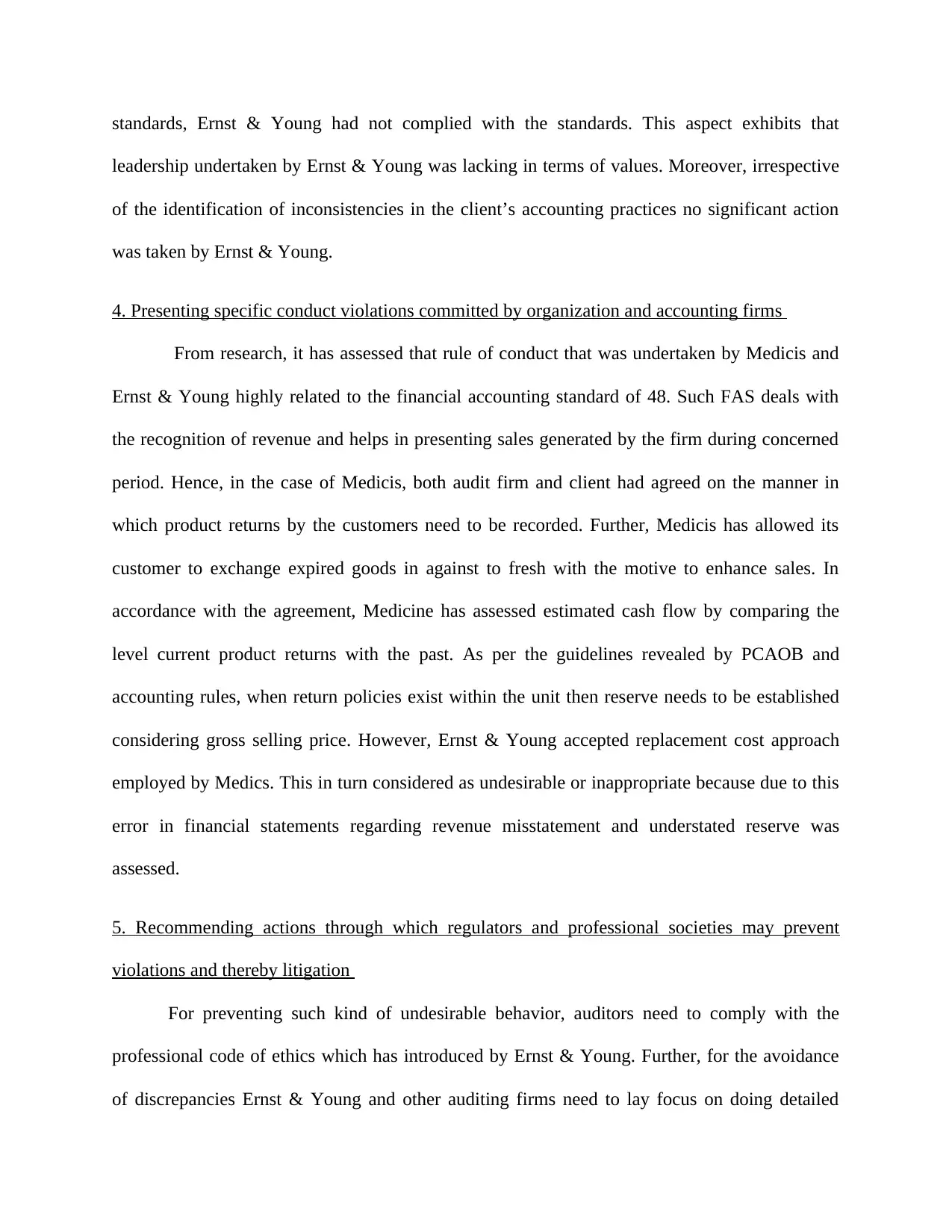
standards, Ernst & Young had not complied with the standards. This aspect exhibits that
leadership undertaken by Ernst & Young was lacking in terms of values. Moreover, irrespective
of the identification of inconsistencies in the client’s accounting practices no significant action
was taken by Ernst & Young.
4. Presenting specific conduct violations committed by organization and accounting firms
From research, it has assessed that rule of conduct that was undertaken by Medicis and
Ernst & Young highly related to the financial accounting standard of 48. Such FAS deals with
the recognition of revenue and helps in presenting sales generated by the firm during concerned
period. Hence, in the case of Medicis, both audit firm and client had agreed on the manner in
which product returns by the customers need to be recorded. Further, Medicis has allowed its
customer to exchange expired goods in against to fresh with the motive to enhance sales. In
accordance with the agreement, Medicine has assessed estimated cash flow by comparing the
level current product returns with the past. As per the guidelines revealed by PCAOB and
accounting rules, when return policies exist within the unit then reserve needs to be established
considering gross selling price. However, Ernst & Young accepted replacement cost approach
employed by Medics. This in turn considered as undesirable or inappropriate because due to this
error in financial statements regarding revenue misstatement and understated reserve was
assessed.
5. Recommending actions through which regulators and professional societies may prevent
violations and thereby litigation
For preventing such kind of undesirable behavior, auditors need to comply with the
professional code of ethics which has introduced by Ernst & Young. Further, for the avoidance
of discrepancies Ernst & Young and other auditing firms need to lay focus on doing detailed
leadership undertaken by Ernst & Young was lacking in terms of values. Moreover, irrespective
of the identification of inconsistencies in the client’s accounting practices no significant action
was taken by Ernst & Young.
4. Presenting specific conduct violations committed by organization and accounting firms
From research, it has assessed that rule of conduct that was undertaken by Medicis and
Ernst & Young highly related to the financial accounting standard of 48. Such FAS deals with
the recognition of revenue and helps in presenting sales generated by the firm during concerned
period. Hence, in the case of Medicis, both audit firm and client had agreed on the manner in
which product returns by the customers need to be recorded. Further, Medicis has allowed its
customer to exchange expired goods in against to fresh with the motive to enhance sales. In
accordance with the agreement, Medicine has assessed estimated cash flow by comparing the
level current product returns with the past. As per the guidelines revealed by PCAOB and
accounting rules, when return policies exist within the unit then reserve needs to be established
considering gross selling price. However, Ernst & Young accepted replacement cost approach
employed by Medics. This in turn considered as undesirable or inappropriate because due to this
error in financial statements regarding revenue misstatement and understated reserve was
assessed.
5. Recommending actions through which regulators and professional societies may prevent
violations and thereby litigation
For preventing such kind of undesirable behavior, auditors need to comply with the
professional code of ethics which has introduced by Ernst & Young. Further, for the avoidance
of discrepancies Ernst & Young and other auditing firms need to lay focus on doing detailed
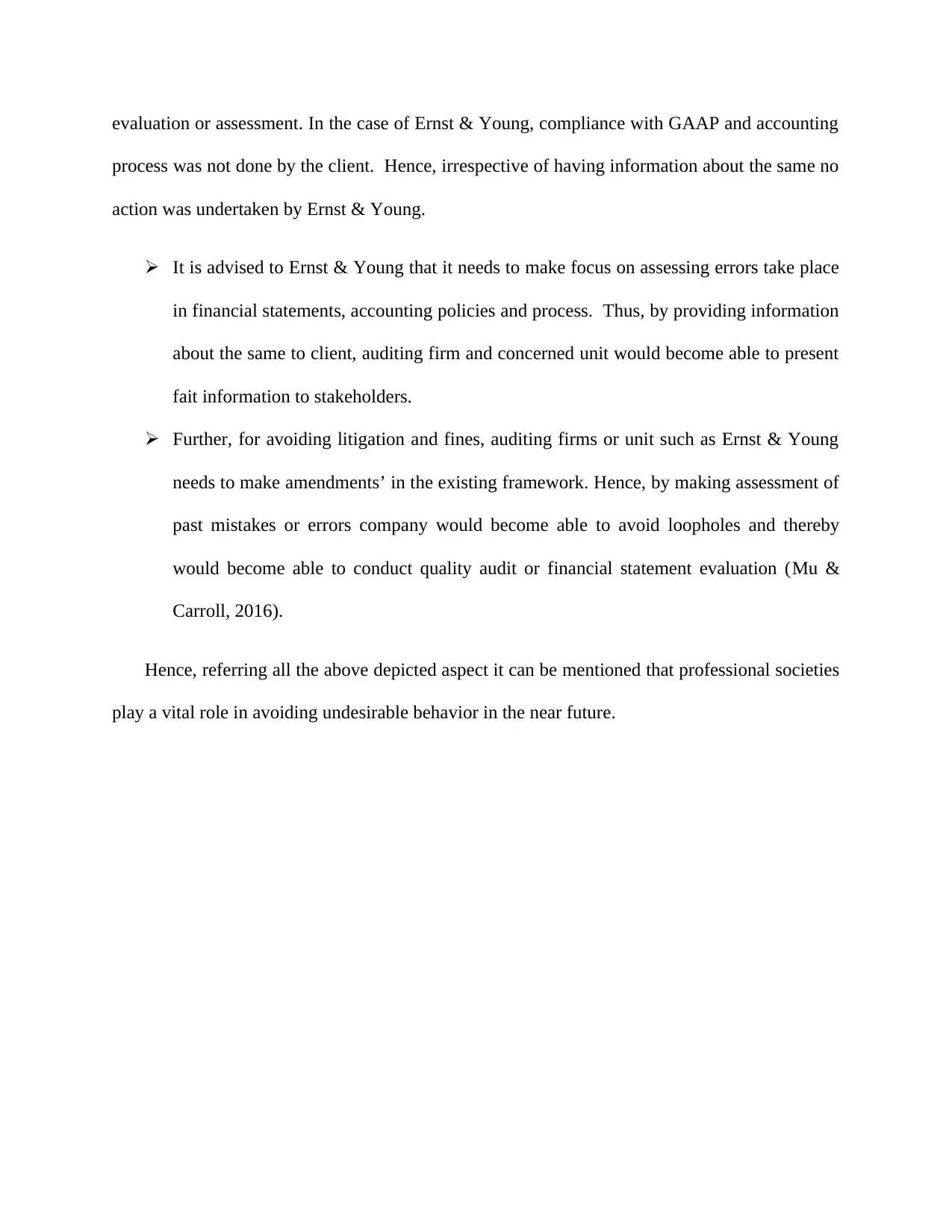
evaluation or assessment. In the case of Ernst & Young, compliance with GAAP and accounting
process was not done by the client. Hence, irrespective of having information about the same no
action was undertaken by Ernst & Young.
It is advised to Ernst & Young that it needs to make focus on assessing errors take place
in financial statements, accounting policies and process. Thus, by providing information
about the same to client, auditing firm and concerned unit would become able to present
fait information to stakeholders.
Further, for avoiding litigation and fines, auditing firms or unit such as Ernst & Young
needs to make amendments’ in the existing framework. Hence, by making assessment of
past mistakes or errors company would become able to avoid loopholes and thereby
would become able to conduct quality audit or financial statement evaluation (Mu &
Carroll, 2016).
Hence, referring all the above depicted aspect it can be mentioned that professional societies
play a vital role in avoiding undesirable behavior in the near future.
process was not done by the client. Hence, irrespective of having information about the same no
action was undertaken by Ernst & Young.
It is advised to Ernst & Young that it needs to make focus on assessing errors take place
in financial statements, accounting policies and process. Thus, by providing information
about the same to client, auditing firm and concerned unit would become able to present
fait information to stakeholders.
Further, for avoiding litigation and fines, auditing firms or unit such as Ernst & Young
needs to make amendments’ in the existing framework. Hence, by making assessment of
past mistakes or errors company would become able to avoid loopholes and thereby
would become able to conduct quality audit or financial statement evaluation (Mu &
Carroll, 2016).
Hence, referring all the above depicted aspect it can be mentioned that professional societies
play a vital role in avoiding undesirable behavior in the near future.
⊘ This is a preview!⊘
Do you want full access?
Subscribe today to unlock all pages.

Trusted by 1+ million students worldwide
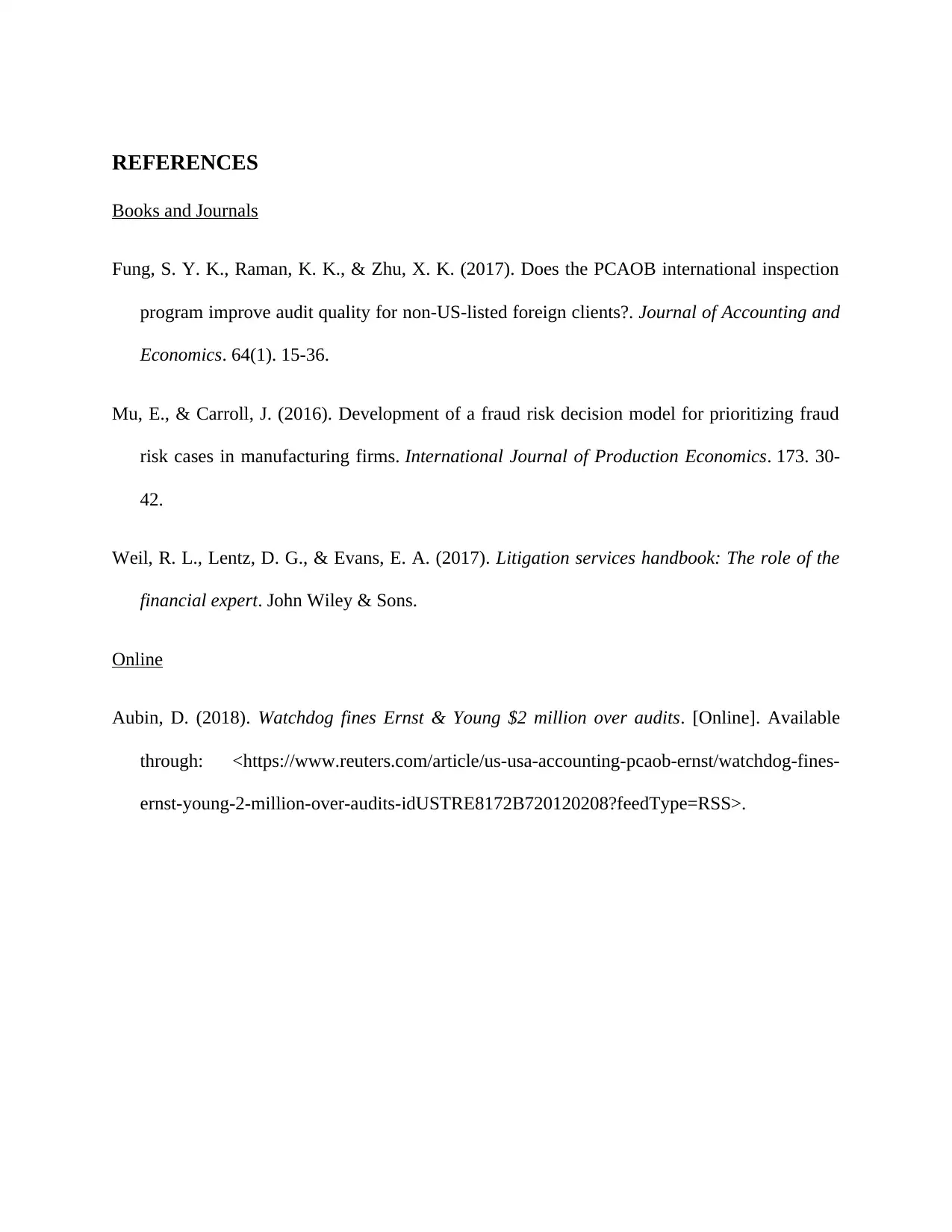
REFERENCES
Books and Journals
Fung, S. Y. K., Raman, K. K., & Zhu, X. K. (2017). Does the PCAOB international inspection
program improve audit quality for non-US-listed foreign clients?. Journal of Accounting and
Economics. 64(1). 15-36.
Mu, E., & Carroll, J. (2016). Development of a fraud risk decision model for prioritizing fraud
risk cases in manufacturing firms. International Journal of Production Economics. 173. 30-
42.
Weil, R. L., Lentz, D. G., & Evans, E. A. (2017). Litigation services handbook: The role of the
financial expert. John Wiley & Sons.
Online
Aubin, D. (2018). Watchdog fines Ernst & Young $2 million over audits. [Online]. Available
through: <https://www.reuters.com/article/us-usa-accounting-pcaob-ernst/watchdog-fines-
ernst-young-2-million-over-audits-idUSTRE8172B720120208?feedType=RSS>.
Books and Journals
Fung, S. Y. K., Raman, K. K., & Zhu, X. K. (2017). Does the PCAOB international inspection
program improve audit quality for non-US-listed foreign clients?. Journal of Accounting and
Economics. 64(1). 15-36.
Mu, E., & Carroll, J. (2016). Development of a fraud risk decision model for prioritizing fraud
risk cases in manufacturing firms. International Journal of Production Economics. 173. 30-
42.
Weil, R. L., Lentz, D. G., & Evans, E. A. (2017). Litigation services handbook: The role of the
financial expert. John Wiley & Sons.
Online
Aubin, D. (2018). Watchdog fines Ernst & Young $2 million over audits. [Online]. Available
through: <https://www.reuters.com/article/us-usa-accounting-pcaob-ernst/watchdog-fines-
ernst-young-2-million-over-audits-idUSTRE8172B720120208?feedType=RSS>.
1 out of 7
Related Documents
Your All-in-One AI-Powered Toolkit for Academic Success.
+13062052269
info@desklib.com
Available 24*7 on WhatsApp / Email
![[object Object]](/_next/static/media/star-bottom.7253800d.svg)
Unlock your academic potential
Copyright © 2020–2025 A2Z Services. All Rights Reserved. Developed and managed by ZUCOL.



